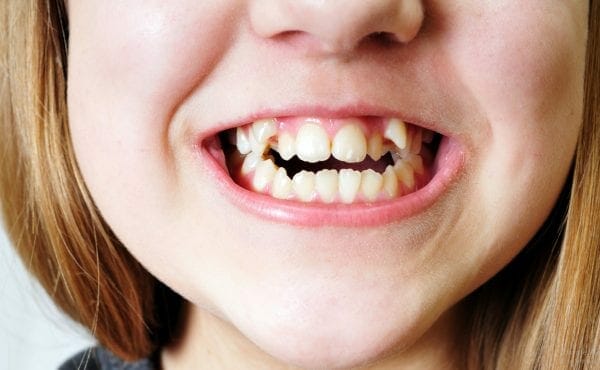Benefits of Early Orthodontics
If your child has straight teeth, it is not necessarily an indication everything is always all right. Early orthodontic screening has many benefits and can find problems the human eye cannot see. In young children, a pediatric orthodontist is adept at evaluating jaw development and underlying issues that may be present with teeth.
The American Dental Association recommends children undergo orthodontic screening by seven years old. Dr. Redford and Dr. Burke provide children in their Temecula and Lake Elsinore offices with a kid-friendly environment.
Importance of Interceptive Orthodontics
Early orthodontic treatment is called interceptive orthodontics (or Phase 1 treatment). The goal of a pediatric orthodontist is to correct emerging problems, thereby creating an ideal environment for adult teeth. Phase 1 treatments concentrate on correcting improper bites and monitoring jaw growth.
 Although an initial screening should occur by age 7, most children do not begin active treatment until the ages of 9 to 14. However, some children need the benefits of early orthodontics. In these cases, early intervention prevents more serious problems later in life. Although children receiving interceptive orthodontics may still require additional orthodontic treatment down the line, treatment is usually shorter and less intense.
Although an initial screening should occur by age 7, most children do not begin active treatment until the ages of 9 to 14. However, some children need the benefits of early orthodontics. In these cases, early intervention prevents more serious problems later in life. Although children receiving interceptive orthodontics may still require additional orthodontic treatment down the line, treatment is usually shorter and less intense.
In addition, this treatment gets results that cannot be achieved after the face and jaw stop growing. Early orthodontics also helps prevent permanent teeth from being damaged by incorrect bites (malocclusions) before permanent teeth erupt.
Conditions Requiring Early Intervention
The following situations require interceptive orthodontics.
- Underbites (lower teeth biting before upper teeth) should be treated by the age of 7 or 8 when jaw growth can be modified. Treatment often involves protraction face masks, retainers, or limited braces.
- Crossbites involve misaligned dental arches and require early treatment with banded and bonded expanders.
- Protruding front teeth create misaligned bites. They also put kids at risk of injuries from accidents (such as falls). Treatment involves overbite correcting appliances, retainers, or limited braces.
- Early loss of baby teeth can be caused by accidents or decay. If the empty space closes up, then permanent teeth do not have a place to erupt. Treatment involves space maintainers or expander devices to regain lost space.
- Teeth crowding should be evaluated before baby teeth are lost. This helps prevent permanent teeth from having to be extracted at a later date. Crowding also increases the possibility of gingivitis. Treatment involves expander appliances to create space or space maintainers.
Sometimes tooth extractions for children are needed to prepare the mouth for orthodontic work. This might happen if a tooth doesn’t fall out when it should—preventing permanent teeth from erupting. Another reason is if a tooth becomes infected or decayed—putting the jaw and surrounding teeth at risk. Extractions may also be required for crowded teeth. In all cases, the removal of teeth is always a last resort.
Breaking the Thumb Sucking Habit
Thumb or finger sucking, along with pacifier use, is acceptable in infants. It is a soothing reflex that provides comfort and security. However, when the habit continues past the age of 4, it can begin to cause problems.
An orthodontic problem associated with thumb sucking is front teeth that jut out, which creates an open bite. This bad habit may also cause teeth to become misaligned and affect the palate. Protrusive front teeth are at higher risk for trauma, especially in active kids.
Many children give up the habit without too much trouble. Often, children figure out on their own that thumb sucking is not acceptable in social situations. This is one of the few times when peer pressure is a good thing! However, some children don’t give up so easily.
If a child is still sucking their thumb in kindergarten, then parents need to intervene. Sometimes a simple chart and reward system is effective. Other children might respond to encouragement and praise.
However, if behavior modification is not working, a Habit appliance might. This is a fixed device that helps patients stop chronic thumb or finger sucking habits. It works by interrupting the bad habit routine. Although it is successful about 90% of the time, other devices can also be used to discourage a child.
What to Expect on Your First Visit
The first visit to a pediatric orthodontist usually starts with a tour of the office and meeting some staff members and the doctor. This helps the child feel more comfortable. Some offices include kid-friendly features in the waiting room or exam area—making the environment fun.
 After the tour, children will receive a thorough clinical examination, including photographs and safe x-rays of the teeth with the latest 3D panoramic imaging device. This will allow the pediatric orthodontist, Dr. Ryan Redford, to determine if treatment is needed and when it should start. After the exam, the doctor will share the results, including a diagnosis, an explanation of any problems, and a recommended course of treatment.
After the tour, children will receive a thorough clinical examination, including photographs and safe x-rays of the teeth with the latest 3D panoramic imaging device. This will allow the pediatric orthodontist, Dr. Ryan Redford, to determine if treatment is needed and when it should start. After the exam, the doctor will share the results, including a diagnosis, an explanation of any problems, and a recommended course of treatment.
For many children, this phase of treatment will not be needed. If so, the doctor will wait for more teeth to erupt before deciding whether orthodontic treatment is required. The child should return for occasional check-ups so the orthodontist can monitor development. This allows orthodontic treatment to begin at the right time.
However, if interceptive orthodontics is required, the pediatric orthodontist will thoroughly explain the recommended treatment and appliances. Impressions or scans of the teeth may be created. The doctor will also discuss the estimated length of treatment and frequency of appointments. Finally, the investment for orthodontic treatment will be clearly explained. After reviewing a patient’s insurance benefits, the staff will provide options for financing with zero interest and payment plans.
Usually, an initial consultation will last approximately one hour, depending on what is found during the clinical exam. If Phase 1 treatment is needed, the next step involves making an appointment to place appliances. Techniques and caring for appliances will be explained, as well as demonstrated.
Helping Children Care for Orthodontic Appliances
Although the pediatric orthodontist will discuss proper oral hygiene and how to care for any appliances, a few helpful tips are provided below.
- Rinse with water after eating and before brushing. This loosens food that may be caught in appliances. Rinsing should be followed by a thorough brushing.
- Floss nightly. Flossing also loosens food debris and plaque around the gum line that might harden into tartar. Flossing reaches areas of the teeth that are inaccessible to toothbrushes. At first, children may need parental assistance with flossing.
- Use a fluoride rinse after brushing and before bed. This helps keep teeth strong and healthy.
- Visit a dentist every 6 months. Even if a child is undergoing orthodontic treatment, regular dental check-ups are still a must. The dentist can point out areas that need more attention, ensuring that a child’s teeth stay healthy and clean. For some kids, it is not a bad idea to consider even a tighter recall schedule.
To learn more about early orthodontics and why Burke & Redford Orthodontists are known as the best pediatric orthodontist offices in Temecula and Lake Elsinore, call our office at (951) 699-8011 to schedule a free consultation. You can also complete the contact form on our website, and our staff will be in touch during business hours. Learn more about braces for children and optional Invisalign treatment and orthodontics for teens.